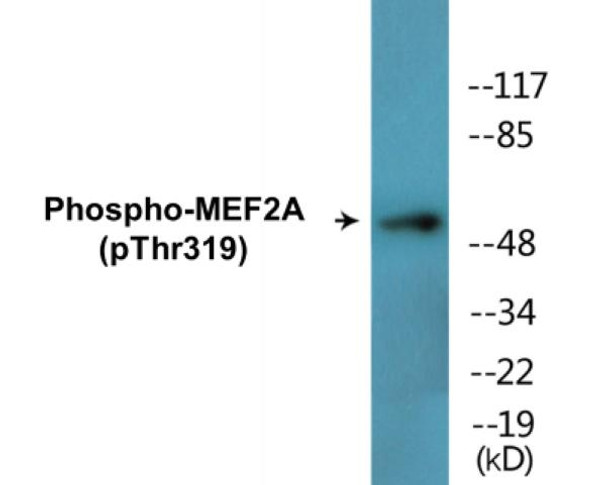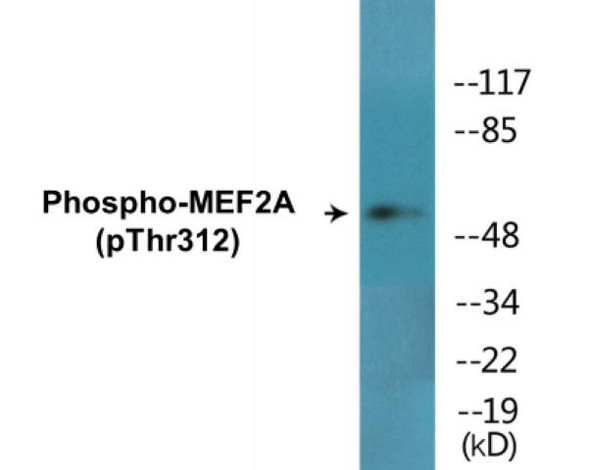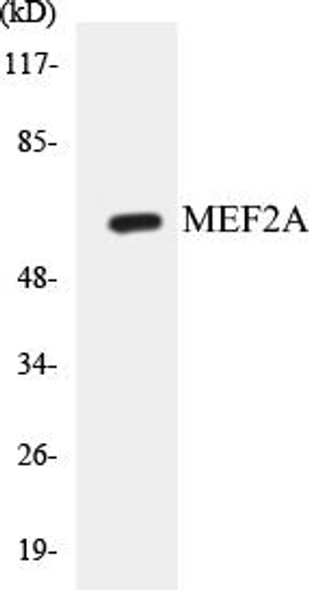Description
MEF2A (Phospho-Thr319)Colorimetric Cell-Based ELISA Kit
The MEF2A Phospho-Thr319 Colorimetric Cell-Based ELISA Kit is specifically designed for the quantitative detection of phosphorylated MEF2A (myocyte enhancer factor 2A) at threonine 319 in cell lysates. This kit offers high sensitivity and accuracy, allowing for reliable and reproducible results in a variety of research settings.MEF2A is a transcription factor that plays a critical role in regulating gene expression in response to various cellular signals. Phosphorylation of MEF2A at threonine 319 is known to modulate its activity and influence key biological processes such as cell differentiation, proliferation, and survival.
The detection of phosphorylated MEF2A at threonine 319 can provide valuable insights into the signaling pathways involved in cell growth, development, and disease progression. This makes the MEF2A Phospho-Thr319 Colorimetric Cell-Based ELISA Kit an indispensable tool for studying MEF2A-mediated signaling pathways and identifying potential therapeutic targets for various diseases, including cancer, cardiovascular disorders, and neurological conditions.
| Product Name: | MEF2A (Phospho-Thr319) Colorimetric Cell-Based ELISA |
| Product Code: | CBCAB01564 |
| ELISA Type: | Cell-Based |
| Target: | MEF2A (Phospho-Thr319) |
| Reactivity: | Human, Mouse, Rat |
| Dynamic Range: | > 5000 Cells |
| Detection Method: | Colorimetric 450 nm |
| Format: | 2 x 96-Well Microplates |
The MEF2A (Phospho-Thr319) Colorimetric Cell-Based ELISA Kit is a convenient, lysate-free, high throughput and sensitive assay kit that can detect MEF2A protein phosphorylation and expression profile in cells. The kit can be used for measuring the relative amounts of phosphorylated MEF2A in cultured cells as well as screening for the effects that various treatments, inhibitors (ie. siRNA or chemicals), or activators have on MEF2A phosphorylation.
Qualitative determination of MEF2A (Phospho-Thr319) concentration is achieved by an indirect ELISA format. In essence, MEF2A (Phospho-Thr319) is captured by MEF2A (Phospho-Thr319)-specific primary (1ø) antibodies while the HRP-conjugated secondary (2ø) antibodies bind the Fc region of the 1ø antibody. Through this binding, the HRP enzyme conjugated to the 2ø antibody can catalyze a colorimetric reaction upon substrate addition. Due to the qualitative nature of the Cell-Based ELISA, multiple normalization methods are needed:
| 1. | A monoclonal antibody specific for human GAPDH is included to serve as an internal positive control in normalizing the target absorbance values. |
| 2. | Following the colorimetric measurement of HRP activity via substrate addition, the Crystal Violet whole-cell staining method may be used to determine cell density. After staining, the results can be analysed by normalizing the absorbance values to cell amounts, by which the plating difference can be adjusted. |
| Database Information: | Gene ID: 4205, UniProt ID: Q02078, OMIM: 600660/608320, Unigene: Hs.268675 |
| Gene Symbol: | MEF2A |
| Sub Type: | Phospho |
| UniProt Protein Function: | MEF2A: a myocyte-specific enhancing transcription factor which binds specifically to the MEF2 element present in the regulatory regions of many, if not all, muscle-specific genes. A member of the MADS gene family that also includes several homeotic genes and other transcription factors, all of which share a conserved DNA-binding domain. Five alternatively spliced isoforms have been reported. |
| UniProt Protein Details: | Protein type:Motility/polarity/chemotaxis; DNA-binding; Transcription factor Chromosomal Location of Human Ortholog: 15q26 Cellular Component: cytoplasm; nuclear chromatin; nucleoplasm; nucleus; transcription factor complex Molecular Function:chromatin binding; histone acetyltransferase binding; histone deacetylase binding; protein binding; protein heterodimerization activity; protein kinase binding; RNA polymerase II transcription factor activity, enhancer binding; sequence-specific DNA binding; SMAD binding; transcription activator binding; transcription factor activity Biological Process: apoptosis; dendrite morphogenesis; heart development; innate immune response; MAPKKK cascade; mitochondrial genome maintenance; mitochondrion distribution; muscle cell differentiation; muscle development; MyD88-dependent toll-like receptor signaling pathway; MyD88-independent toll-like receptor signaling pathway; negative regulation of transcription from RNA polymerase II promoter; nerve growth factor receptor signaling pathway; positive regulation of muscle cell differentiation; positive regulation of transcription from RNA polymerase II promoter; stress-activated MAPK cascade; toll-like receptor 10 signaling pathway; toll-like receptor 2 signaling pathway; toll-like receptor 3 signaling pathway; toll-like receptor 4 signaling pathway; toll-like receptor 5 signaling pathway; toll-like receptor 9 signaling pathway; toll-like receptor signaling pathway; transcription from RNA polymerase II promoter; transcription, DNA-dependent; ventricular cardiac myofibril development Disease: Coronary Artery Disease, Autosomal Dominant, 1 |
| NCBI Summary: | The protein encoded by this gene is a DNA-binding transcription factor that activates many muscle-specific, growth factor-induced, and stress-induced genes. The encoded protein can act as a homodimer or as a heterodimer and is involved in several cellular processes, including muscle development, neuronal differentiation, cell growth control, and apoptosis. Defects in this gene could be a cause of autosomal dominant coronary artery disease 1 with myocardial infarction (ADCAD1). Several transcript variants encoding different isoforms have been found for this gene.[provided by RefSeq, Jan 2010] |
| UniProt Code: | Q02078 |
| NCBI GenInfo Identifier: | 1170908 |
| NCBI Gene ID: | 4205 |
| NCBI Accession: | Q02078.1 |
| UniProt Secondary Accession: | Q02078,O43814, Q14223, Q14224, Q59GX4, Q7Z6C9, Q96D14 B4DFQ7, F6XG23, |
| UniProt Related Accession: | Q02078 |
| Molecular Weight: | 45,570 Da |
| NCBI Full Name: | Myocyte-specific enhancer factor 2A |
| NCBI Synonym Full Names: | myocyte enhancer factor 2A |
| NCBI Official Symbol: | MEF2A |
| NCBI Official Synonym Symbols: | mef2; ADCAD1; RSRFC4; RSRFC9 |
| NCBI Protein Information: | myocyte-specific enhancer factor 2A |
| UniProt Protein Name: | Myocyte-specific enhancer factor 2A |
| UniProt Synonym Protein Names: | Serum response factor-like protein 1 |
| Protein Family: | Myocyte-specific enhancer factor |
| UniProt Gene Name: | MEF2A |
| UniProt Entry Name: | MEF2A_HUMAN |
| Component | Quantity |
| 96-Well Cell Culture Clear-Bottom Microplate | 2 plates |
| 10X TBS | 24 mL |
| Quenching Buffer | 24 mL |
| Blocking Buffer | 50 mL |
| 15X Wash Buffer | 50 mL |
| Primary Antibody Diluent | 12 mL |
| 100x Anti-Phospho Target Antibody | 60 µL |
| 100x Anti-Target Antibody | 60 µL |
| Anti-GAPDH Antibody | 60 µL |
| HRP-Conjugated Anti-Rabbit IgG Antibody | 12 mL |
| HRP-Conjugated Anti-Mouse IgG Antibody | 12 mL |
| SDS Solution | 12 mL |
| Stop Solution | 24 mL |
| Ready-to-Use Substrate | 12 mL |
| Crystal Violet Solution | 12 mL |
| Adhesive Plate Seals | 2 seals |
The following materials and/or equipment are NOT provided in this kit but are necessary to successfully conduct the experiment:
- Microplate reader able to measure absorbance at 450 nm and/or 595 nm for Crystal Violet Cell Staining (Optional)
- Micropipettes with capability of measuring volumes ranging from 1 µL to 1 ml
- 37% formaldehyde (Sigma Cat# F-8775) or formaldehyde from other sources
- Squirt bottle, manifold dispenser, multichannel pipette reservoir or automated microplate washer
- Graph paper or computer software capable of generating or displaying logarithmic functions
- Absorbent papers or vacuum aspirator
- Test tubes or microfuge tubes capable of storing ≥1 ml
- Poly-L-Lysine (Sigma Cat# P4832 for suspension cells)
- Orbital shaker (optional)
- Deionized or sterile water
*Note: Protocols are specific to each batch/lot. For the correct instructions please follow the protocol included in your kit.
| Step | Procedure |
| 1. | Seed 200 µL of 20,000 adherent cells in culture medium in each well of a 96-well plate. The plates included in the kit are sterile and treated for cell culture. For suspension cells and loosely attached cells, coat the plates with 100 µL of 10 µg/ml Poly-L-Lysine (not included) to each well of a 96-well plate for 30 minutes at 37 °C prior to adding cells. |
| 2. | Incubate the cells for overnight at 37 °C, 5% CO2. |
| 3. | Treat the cells as desired. |
| 4. | Remove the cell culture medium and rinse with 200 µL of 1x TBS, twice. |
| 5. | Fix the cells by incubating with 100 µL of Fixing Solution for 20 minutes at room temperature. The 4% formaldehyde is used for adherent cells and 8% formaldehyde is used for suspension cells and loosely attached cells. |
| 6. | Remove the Fixing Solution and wash the plate 3 times with 200 µL 1x Wash Buffer for five minutes each time with gentle shaking on the orbital shaker. The plate can be stored at 4 °C for a week. |
| 7. | Add 100 µL of Quenching Buffer and incubate for 20 minutes at room temperature. |
| 8. | Wash the plate 3 times with 1x Wash Buffer for 5 minutes each time. |
| 9. | Add 200 µL of Blocking Buffer and incubate for 1 hour at room temperature. |
| 10. | Wash 3 times with 200 µL of 1x Wash Buffer for 5 minutes each time. |
| 11. | Add 50 µL of 1x primary antibodies Anti-MEF2A (Phospho-Thr319) Antibody, Anti-MEF2A Antibody and/or Anti-GAPDH Antibody) to the corresponding wells, cover with Parafilm and incubate for 16 hours (overnight) at 4 °C. If the target expression is known to be high, incubate for 2 hours at room temperature. |
| 12. | Wash 3 times with 200 µL of 1x Wash Buffer for 5 minutes each time. |
| 13. | Add 50 µL of 1x secondary antibodies (HRP-Conjugated AntiRabbit IgG Antibody or HRP-Conjugated Anti-Mouse IgG Antibody) to corresponding wells and incubate for 1.5 hours at room temperature. |
| 14. | Wash 3 times with 200 µL of 1x Wash Buffer for 5 minutes each time. |
| 15. | Add 50 µL of Ready-to-Use Substrate to each well and incubate for 30 minutes at room temperature in the dark. |
| 16. | Add 50 µL of Stop Solution to each well and read OD at 450 nm immediately using the microplate reader. |
(Additional Crystal Violet staining may be performed if desired – details of this may be found in the kit technical manual.)






